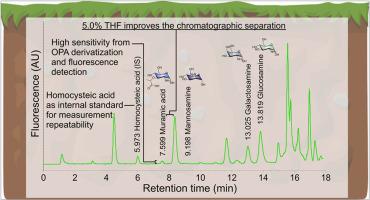改良的快速高效液相色谱法定量土壤氨基糖-与气相色谱法相比,提高了灵敏度
IF 10.3
1区 农林科学
Q1 SOIL SCIENCE
引用次数: 0
摘要
通过测定土壤氨基糖进行土壤微生物坏死块分析是土壤科学中常用的技术。传统上,测量是通过乙腈醋酸酯衍生化和气相色谱(GC)分析进行的。较长的前处理时间和较高的定量限(LOQ)使得高效液相色谱(HPLC)方法发展得更快、更灵敏。在本研究中,我们通过将之前发现的邻苯二醛衍生化和高效液相色谱分离方法转化为超高高效液相色谱(UHPLC)柱和设备,对土壤样品进行了改进。我们还增加了一个内部标准来控制预处理的变化。此外,我们还探讨了在不同设备下建立该方法必须优化的因素,以及UHPLC与GC方法结果的差异。我们发现UHPLC法的测定结果与葡萄糖胺和半乳糖胺的气相色谱法相似,而UHPLC法的测定效果明显更好,特别是在低浓度下。甘露糖胺的结果在不同的方法之间没有相关性。与气相色谱法相比,UHPLC的分析速度更快,LOQ更低。在大多数土壤样品中(18个样品中有13个),用气相色谱法检测到的乳酸菌酸浓度低于定量限,但用所开发的UHPLC法可以清楚地检测到。结果表明,UHPLC法的检测速度至少是GC法的两倍,而且只需要很少的传统氨基糖分析中使用的有害化学物质。UHPLC法在HPLC法的基础上进行了改进,仅消耗总溶剂的1/5,并将分析时间从30分钟减少到18分钟。本文章由计算机程序翻译,如有差异,请以英文原文为准。

Modified fast UHPLC method for quantification of soil amino sugars – improved sensitivity compared to the GC method
Soil microbial necromass analysis through measurement of soil amino sugars is a common technique in soil science. Traditionally, the measurement is performed by aldononitrile acetate derivatization and gas chromatographic (GC) analysis. Long pretreatment times and high limits of quantification (LOQ) have led to the development of faster and more sensitive high performance liquid chromatography (HPLC) methods. In this study, we enhanced a previously discovered ortho-phthalaldehyde derivatization and HPLC separation method for soil samples by converting it to work with ultra-high performance liquid chromatography (UHPLC) column and equipment. We also added an internal standard to control for pretreatment variation. In addition, we explored the factors that must be optimized to establish the method with alternative equipment, and the differences in the results between the UHPLC and the GC methods. We found that the UHPLC method produced similar results to the GC methods with glucosamine and galactosamine, while the performance of the UHPLC method was significantly better in determining muramic acid, especially at low concentrations. Mannosamine results were not correlated between the methods. The speed of the UHPLC analysis was much higher and LOQ much lower compared to the GC method. In the majority of soil samples (13 out of 18), muramic acid concentrations were found to be below LOQ for the GC method, but clearly detectable with the developed UHPLC method. It was found that the UHPLC method is at least twice as fast as the GC method and requires only few of the hazardous chemicals traditionally used in amino sugar analysis. The UHPLC method also improved on the HPLC method by consuming only 1/5th of the total solvent and by reducing analysis time from 30 to 18 minutes.
求助全文
通过发布文献求助,成功后即可免费获取论文全文。
去求助
来源期刊

Soil Biology & Biochemistry
农林科学-土壤科学
CiteScore
16.90
自引率
9.30%
发文量
312
审稿时长
49 days
期刊介绍:
Soil Biology & Biochemistry publishes original research articles of international significance focusing on biological processes in soil and their applications to soil and environmental quality. Major topics include the ecology and biochemical processes of soil organisms, their effects on the environment, and interactions with plants. The journal also welcomes state-of-the-art reviews and discussions on contemporary research in soil biology and biochemistry.
 求助内容:
求助内容: 应助结果提醒方式:
应助结果提醒方式:


